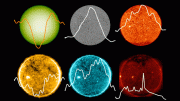
Scientists found that raindrops falling through the air dissipate a significant portion of the energy driving wind and air circulation in Earth’s atmosphere.
A new study published in the journal Science states that rainfall soothes the atmosphere, almost as much as turbulence. They calculated that a substantial portion of the energy that drives wind and air circulation in the Earth’s atmosphere is dissipated as friction by raindrops falling through the air.
In essence, the atmosphere acts like a heat engine that generates mechanical energy by moving heat from the Earth’s surface, which was warmed by the sun, to the colder air above. Some of that energy becomes kinetic, driving movements from large-scale flows such as jet streams to small gusts and eddies. This energy is ultimately dissipated in turbulence, molecules of air swirling around chaotically, slightly warming up as a consequence.
Atmospheric researchers have found that some of the dissipation happens when falling raindrops, snowflakes, or hailstones, experience friction as they pass through the surrounding air. Olivier Pauluis and Juliana Dias, atmospheric scientists at the US National Oceanic and Atmospheric Administration (NOAA) in Boulder, California, have found that on a global scale, enough precipitation falls to dissipate as much energy as turbulence.
It is somewhat counterintuitive that so much energy can be dissipated by this as the turbulent cascade of energy from jet streams and storms of all kinds, but it’s something that has been long suspected by atmospheric scientists.
Kevin Trenberth, an atmospheric scientist at the US National Center for Atmospheric Research in Boulder, states that the amount of kinetic energy involved is still quite small compared to the total amount of energy bound up in the climate system, which adds up to about 240 watts per square meter of the Earth’s surface. Dissipation from rainfall accounts for 0.75% of that total.
Paulius and Dias derived their energy estimates from satellite measurements of the rates of global precipitation. Using this, they calculated how much frictional drag the droplets experienced.
It’s difficult to assess what this could mean for specific weather systems. These changes could be dwarfed by the wider changes caused by global warming.
Reference: “Satellite Estimates of Precipitation-Induced Dissipation in the Atmosphere” by Olivier Pauluis and Juliana Dias, 24 February 2012, Science.
DOI: 10.1126/science.1215869









Be the first to comment on "Friction on Raindrops Dissipates Almost as Much Atmospheric Energy as Turbulence"